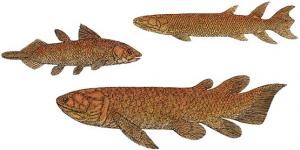Sarcopterygii (Sarcopterygians)
The Sarcopterygii constitute a clade (traditionally a class or subclass) of the bony fishes, though a strict classification would include the terrestrial vertebrates. The living sarcopterygians are the coelacanths, lungfishes, and the tetrapods.
Early sarcopterygians - crossopterygians are bony fish with fleshy, lobed, paired fins, which are joined to the body by a single bone. The fins of crossopterygians differ from those of all other fish in that each is borne on a fleshy, lobelike, scaly stalk extending from the body. Pectoral and pelvic fins have articulations resembling those of tetrapod limbs. These fins evolved into legs of the first tetrapod land vertebrates, amphibians. They also possess two dorsal fins with separate bases, as opposed to the single dorsal fin of actinopterygians (ray-finned fish). The braincase of sarcoptergygians primitively has a hinge line, but this is lost in tetrapods and lungfish. Many early sarcopterygians have a symmetrical tail. All sarcopterygians possess teeth covered with true enamel.
Taxonomists who subscribe to the cladistic approach include the grouping Tetrapoda within this group, which in turn consists of all species of four-limbed vertebrates. The fin-limbs of sarcopterygians such as the coelacanths show a strong similarity to the expected ancestral form of tetrapod limbs. The crossopterygians apparently followed two different lines of development and are accordingly separated into two subclasses, the Rhipidistia (including the Dipnoi or lungfish, and the Tetrapodomorpha which include the Tetrapoda) and the Actinistia (coelacanths).
Sarcopterygians and their relatives the actinopterygians ("ray-finned fish") comprise the superclass Osteichthyes, the "bony fish", characterized by their bony skeleton rather than cartilage. There are otherwise vast differences in fin, respiratory, and circulatory structures between the Sarcopterygii and the Actinopterygii. The first sarcopterygians, found in the uppermost Silurian (ca 418 Ma), closely resembled the Acanthodians (the "spiny fish", a taxon that went extinct at the end of the Paleozoic). In the early–middle Devonian (416 - 385 Ma), while the predatory placoderms dominated the seas, some sarcopterygians came into freshwater habitats.
In the Early Devonian (416 - 397 Ma), the sarcopterygians split into two main lineages — the coelacanths and the rhipidistians. The former never left the oceans and their heyday was the late Devonian and Carboniferous, from 385 to 299 Ma, as they were more common during those periods than in any other period in the Phanerozoic; coelacanths still live today in the oceans (genus Latimeria).
The Rhipidistians, whose ancestors probably lived in the oceans near the river mouths (estuaries), left the ocean world and migrated into freshwater habitats. They in turn split into two major groups : the lungfish and the tetrapodomorphs. The lungfish evolved the first proto-lungs and proto-limbs; they learned in the middle Devonian (397 - 385 Ma) how to live outside a water environment, using their stubby fins (proto-limbs) to walk on land and find new water if their waterhole was depleted, and their lungs to breathe air and get sufficient oxygen. The lungfish'||chr(39)||'s greatest diversity was in the Triassic period; today there are fewer than a dozen genera left.
The first tetrapodomorphs, which included the gigantic rhizodonts, had the same general anatomy as the lungfish, who were their closest kin, but they appear not to have left their water habitat until the late Devonian epoch (385 - 359 Ma), with the appearance of tetrapods (four-legged vertebrates). Tetrapods are the only tetrapodomorphs which survived after the Devonian. Non-tetrapod sarcopterygians continued until towards the end of Paleozoic era, suffering heavy losses during the Permian-Triassic extinction event (251 Ma).
Source> http://en.wikipedia.org/wiki/Sarcopterygii | ||
Virtual museum of the Czech Geological Survey, www.geology.cz, (C) Czech Geological Survey, 2011, v.0.99 [13.12.2011]


![[ENG]](img/vlajka-cr.gif) Česky
Česky 

